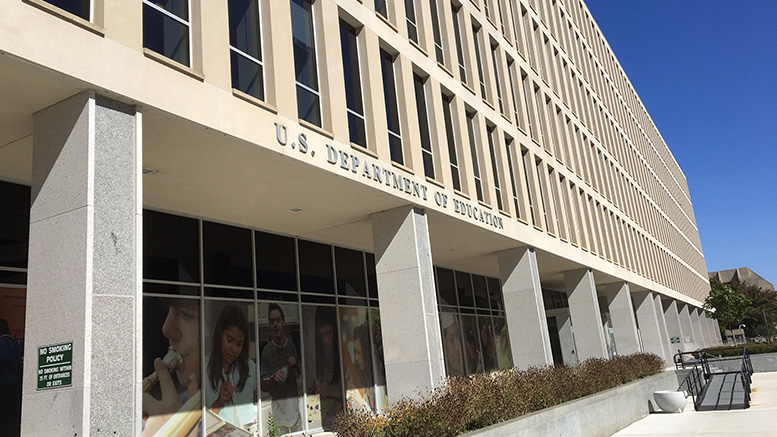Washington Watch is produced by the American Association of Community Colleges‘ office of government relations and policy analysis.
The U.S. Education Department (ED) on October 9 announced its rescission of the Campus Safety and Security Reporting handbook (better known as Clery Act guidelines) and replacement with a new Appendix.

The 13-page Appendix to the Federal Student Aid Handbook (FSA) replaced the 265-page Handbook that was last updated in 2016 under the Obama Administration.
ED’s statement made clear that “the contents of the new Appendix do not have the force and effect of law and are not meant to bind the public. The document is intended only to provide clarity to the public regarding existing requirements under the applicable statutory and regulatory provisions.”
This action involves the guidelines and not the Clery Act itself, which is part of the Higher Education Act (HEA) and remains intact.
Clery Act background
The HEA was amended in 1990 to include the Crime Awareness and Campus Security Act, requiring postsecondary institutions participating in Title IV student financial assistance programs to disclose campus crime statistics and security information. When the HEA was reauthorized in 1998, it changed the name of the law to the Jeanne Clery Disclosure of Campus Security Policy and Campus Crime Statistics Act.
Subsequently, the Clery Act was amended in 2013 during the reauthorization of the Violence Against Women Act. Institutions were now required to disclose information related to new offenses, including dating violence, domestic violence, sexual assault and stalking.
Rationale for guidelines replacement
The handbook was prepared for the purpose of providing institutions with ED’s interpretations and guidance to assist “in a step-by-step and readable manner in understanding and meeting the various HEA requirements. It is intended for use by the department’s program reviewers who are responsible for evaluating an institution’s compliance with the requirements as well as postsecondary institutions and outside reviewers.”
Although the handbook was only meant to offer guidelines, ED believes many institutions followed them as if they were controlling.
In rescinding the handbook, ED cited a 2015 report of a Senate Task Force on Regulation of Higher Education, Recalibrating Regulation of Colleges and Universities, which listed the Clery Act Handbook among others, in a section titled “Challenges to Higher Education in the Current Regulatory Environment: Regulations Are Unnecessarily Voluminous.” Extensive reporting and disclosure requirements, according to the report, created a considerable burden for some institutions.
Having concluded that the 2016 handbook “did not achieve the department’s goal of ensuring that adequate information is available to the public to foster improved campus safety and security…the department began a holistic process of eliminating guidance that extended beyond the statutory and regulatory requirements,” according to the announcement. The stated intent of the process was “reducing regulatory confusion,” and the intent of the rescission and publication of the new appendix is “to help simplify Clery compliance.”
Some changes highlighted
The announcement highlighted several of the changes addressed by the new appendix, including those related to Clery Act geography, crimes and campus security authorities.
Unlike the 2016 handbook that defined the term “reasonably contiguous” geographic area as one mile away from the campus border for which Clery Act instances must be reported, the Appendix no longer has a specific measure.
In a related matter concerning the definition of public property, the Appendix removes the instruction for reporting instances occurring on the sidewalk or street, which, according to ED, are not provided for in the statute or regulation. Furthermore, the Appendix also addresses requirements concerning the reporting of crimes that occur abroad during institution-sponsored trips.
ED depicted the definitions for Clery crimes contained in the 2016 handbook, as well as the accompanying explanations, summaries, and examples as “creat[ing] misperceptions and confusion for institutions attempting to properly interpret and apply the definitions.” Therefore, these were deleted and replaced with those referenced in the appropriate regulation (34 CFR 668.46(c)(9) and Appendix A to subpart D of part 668.
ED believes that the handbook expanded the definition of campus security authorities (CSAs) found in the regulation ((34 CFR 668.46(a)) and by doing so, covered individuals who, according to ED, did not have “significant responsibility for student and campus activities.”
The new guidance identifies institutions as responsible for identifying CSAs, not ED. “It is beyond the department’s authority to disagree with that reasonable determination,” the guidelines state.
To help understand the new guidelines, whose stated intent is to alleviate institutional burden and remove confusion, all in the aid of institutions complying with the Clery regulations, the American Association of Community Colleges urges its members to keep an eye out for ED webinars and other communications.
On a final note, ED reminds institutions that “none of the changes in the Appendix impact the July 10, 2020, temporary extension (to December 31, 2020) that the department provided, regarding Clery reporting due to COVID-19.”





